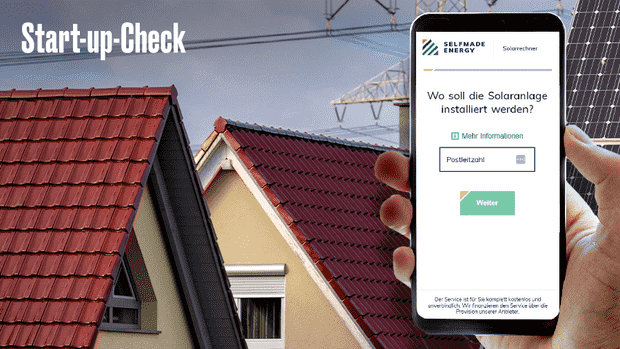Dusseldorf There is a comparison calculator on the Internet for homeowners who want to build a photovoltaic system on their roof. A few clicks lead to an overview of offers – without a craftsman having to inspect the house roof on site beforehand. The number of users of the “Selfmade Energy” website is currently doubling every few months.
Is the service worth it? The Handelsblatt took a closer look at the portal and gives an overview.
Photovoltaic systems for the roof are extremely popular. Many people want to do something to counteract the high electricity prices, protect the climate or supposedly be more independent in supplying themselves with energy. But there are too few craftsmen to meet the high demand. This makes photovoltaic systems unusually expensive.
But if you want to compare several offers, you have to bring a lot of patience. A craft business has to be found, an employee has to come and inspect the roof, then it can take weeks before the offer comes. And if you finally have several offers, you may have difficulties comparing them meaningfully.
What can the “Selfmade Energy” website do?
The portal first asks the user for a variety of non-binding information: postal code, is the user the homeowner himself, how many people live in the house, is it a single-family house, an apartment building or a terraced house or a commercial property, what is the pitch and condition of the roof, how Is the house old, should the roof be renovated first, do you have an electric car and a heat pump, does the user also want battery storage, what is the desired date for the installation?
The portal then calculates how many modules are needed to cover its own power requirements. If you give your exact address, you will also find out whether your own roof is big enough for it. For most regions in Germany, Selfmade Energy uses data from so-called solar cadastres, which each federal state maintains, and thus recognizes the size and inclination of the roof as well as possible shading from trees or other houses. In some regions and countries – for example in Bavaria – this has not yet worked because the portal operator does not have the necessary data.
If you also enter your e-mail address in the next step, you will receive suitable offers for your own requirements. If you select an offer and enter your name and telephone number, you will receive an SMS with a link on your mobile phone. There, users can upload photos of their roof taken with their cell phones. So the solar companies don’t have to send a craftsman over to take stock.
What are the goals of “Selfmade Energy” and who is behind it?
The company operating the website is called Tiro Check Energy – an obvious name, because the man who founded the company in 2019 with his private money is called Tim Rosengart. He wanted to create an easy way to check your own energy production potential.
The 37-year-old founder of the “Selfmade Energy” comparison portal previously worked in political communication for an electricity meter provider.
Rosengart, who is now 37, previously worked for the electricity meter provider and metering point operator Discovergy. He founded Tiro Check Energy after he had to invest a lot of time to find comparable offers for photovoltaic systems for his parents. “I had a lot of craftsmen at home – they all asked the same questions and took the same photos,” says Rosengart.
In the meantime, some well-known investors have invested in Rosengart’s company with a total of seven-figure sums of money, including the founder of the comparison portal Verivox, Nikolaus Starzacher, and the founder of the battery storage company Sonnen, Christoph Ostermann.
What will change as a result of “Selfmade Energy”?
Investor Christoph Ostermann says: “The solar market has never been as big as it is today. And it is extremely non-transparent.” There is a variety of solar offers – from electricians and solar companies, as direct purchase, rental or leasing models. Ostermann therefore describes “Selfmade Energy” as “the missing piece of the puzzle”.
Rosengart not only wants to support users with its portal, but also relieve craftsmen. He says: “We deliver the customers to the solar companies on a silver platter.” The companies can store exclusion criteria – thanks to the many pre-selection criteria, the solar installers only receive inquiries from customers whose roof meets the right criteria. That is why it is the solar companies – and not the households – that pay for “self-made energy”.
What do critics say?
The advice portal Finanztip has tested and recommended “Selfmade Energy”. Benjamin Weigl, Finanztip expert for energy, also says: “Many offers for PV systems are currently overpriced. You should therefore not blindly trust such comparison portals, but also ask other, regional providers about the prices. You can often get away with it several thousand euros cheaper.”
>> Read also: Start-up check for “One D” – This battery start-up electrifies the car company GM
The demand is currently so high that you have to be patient. If you are not in too much of a hurry with the PV system, and if you accept longer delivery times, you would find cheaper offers.
The consumer advocate Sören Demandt specifies: “For most private individuals, the limit to inefficiency is somewhere between 2500 and 3000 euros per kilowatt peak.” That applies to systems without storage and depends on several factors. Demandt says: “Despite the current price situation, it can make sense to get offers now.” How the market will develop is difficult to say. “But there are currently offers that are financially attractive.”
More: Profit skimming plans split renewables industry

